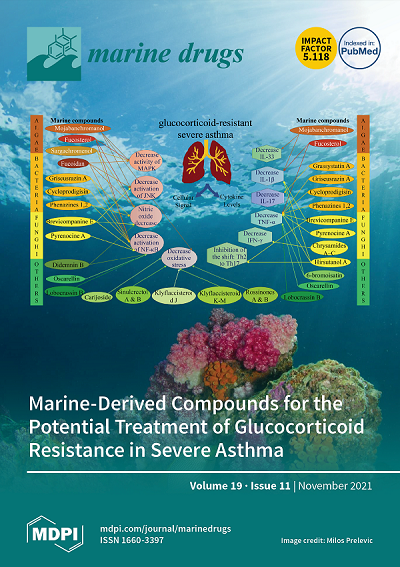Sphaerococcenol A Derivatives: Design, Synthesis, and Cytotoxicity
IF 4.9
2区 医学
Q1 CHEMISTRY, MEDICINAL
引用次数: 0
Abstract
Sphaerococcenol A is a cytotoxic bromoditerpene biosynthesized by the red alga Sphaerococcus coronopifolius. A series of its analogues (1–6) was designed and semi-synthesized using thiol-Michael additions and enone reduction, and the structures of these analogues were characterized by spectroscopic methods. Cytotoxic analyses (1–100 µM; 24 h) were accomplished on A549, DU-145, and MCF-7 cells. The six novel sphaerococcenol A analogues displayed an IC50 range between 14.31 and 70.11 µM on A549, DU-145, and MCF-7 malignant cells. Compound 1, resulting from the chemical addition of 4-methoxybenzenethiol, exhibited the smallest IC50 values on the A549 (18.70 µM) and DU-145 (15.82 µM) cell lines, and compound 3, resulting from the chemical addition of propanethiol, exhibited the smallest IC50 value (14.31 µM) on MCF-7 cells. The highest IC50 values were exhibited by compound 4, suggesting that the chemical addition of benzylthiol led to a loss of cytotoxic activity. The remaining chemical modifications were not able to potentiate the cytotoxicity of the original compounds. Regarding A549 cell viability, analogue 1 exhibited a marked effect on mitochondrial function, which was accompanied by an increase in ROS levels, Caspase-3 activation, and DNA fragmentation and condensation. This study opens new avenues for research by exploring sphaerococcenol A as a scaffold for the synthesis of novel bioactive molecules.Sphaerococcenol A 衍生物:设计、合成和细胞毒性
Sphaerococcenol A 是由红藻 Sphaerococcus coronopifolius 生物合成的一种具有细胞毒性的溴二萜。利用硫醇-迈克尔加成法和烯酮还原法设计并半合成了一系列类似物(1-6),并通过光谱方法对这些类似物的结构进行了表征。对 A549、DU-145 和 MCF-7 细胞进行了细胞毒性分析(1-100 µM;24 小时)。六种新型水飞蓟素 A 类似物对 A549、DU-145 和 MCF-7 恶性细胞的 IC50 值介于 14.31 至 70.11 µM 之间。化合物 1 由 4-甲氧基苯硫酚化学添加而成,对 A549(18.70 µM)和 DU-145 (15.82 µM)细胞系的 IC50 值最小;化合物 3 由丙硫醇化学添加而成,对 MCF-7 细胞的 IC50 值最小(14.31 µM)。化合物 4 的 IC50 值最高,这表明苄硫醇的化学添加导致了细胞毒性活性的丧失。其余的化学修饰不能增强原始化合物的细胞毒性。关于 A549 细胞的活力,类似物 1 对线粒体功能有明显影响,同时伴随着 ROS 水平升高、Caspase-3 激活、DNA 断裂和凝结。这项研究开辟了一条新的研究途径,即探索以海黄皮杉醇 A 为支架合成新型生物活性分子。
本文章由计算机程序翻译,如有差异,请以英文原文为准。
求助全文
约1分钟内获得全文
求助全文
来源期刊

Marine Drugs
医学-医药化学
CiteScore
9.60
自引率
14.80%
发文量
671
审稿时长
1 months
期刊介绍:
Marine Drugs (ISSN 1660-3397) publishes reviews, regular research papers and short notes on the research, development and production of drugs from the sea. Our aim is to encourage scientists to publish their experimental and theoretical research in as much detail as possible, particularly synthetic procedures and characterization information for bioactive compounds. There is no restriction on the length of the experimental section.
 求助内容:
求助内容: 应助结果提醒方式:
应助结果提醒方式:


